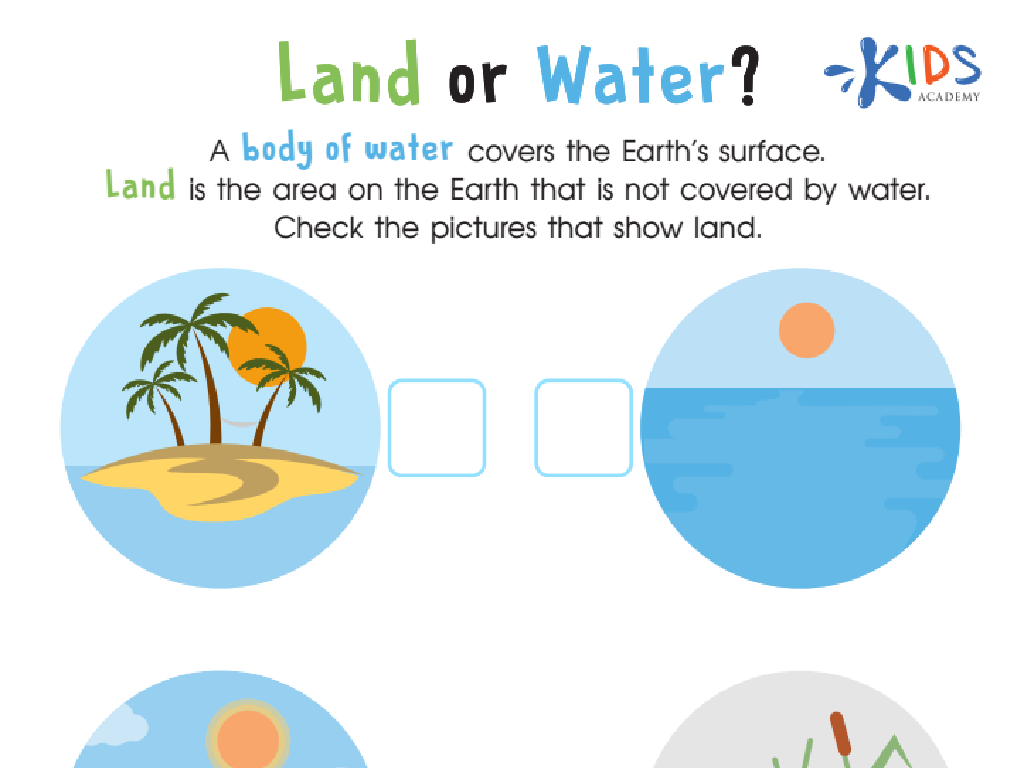Life On Earth And In The Universe
Subject: Science
Grade: High school
Topic: Cosmology And Astronomy
Please LOG IN to download the presentation. Access is available to registered users only.
View More Content
Exploring Our Cosmic Address
– Our place in the cosmos
– Earth is part of a vast universe, in the Milky Way galaxy.
– Defining Cosmology & Astronomy
– Cosmology studies the universe’s origin & evolution; Astronomy is the study of celestial objects.
– Life on Earth’s uniqueness
– Earth’s perfect conditions for life: water, atmosphere, temperature.
– Life’s potential in the universe
– The search for extraterrestrial life examines planets with Earth-like conditions.
|
This slide introduces students to the grand scale of cosmology and astronomy, setting the stage for understanding Earth’s place in the universe. It differentiates between cosmology, the study of the universe’s large-scale properties and its history, and astronomy, which focuses on individual celestial bodies. Highlight Earth’s unique position as the only known planet with life, due to its perfect blend of water, atmosphere, and temperature. Finally, touch on the ongoing scientific quest to find life beyond Earth, looking at planets and moons within and outside our solar system that may have conditions similar to our own. Encourage students to ponder the possibilities of life elsewhere and the implications for our understanding of life on Earth.
The Big Bang: Universe’s Origin
– The Big Bang Theory explained
– A singularity expanding into the universe as we know it
– Universe’s expansion and evolution
– From rapid inflation to the growth of cosmic structures
– Formation of galaxies and stars
– Gravity pulled matter to form galaxies, then stars ignited
– Planet creation process
– Dust and gas around stars clumped together to form planets
|
This slide introduces the Big Bang Theory as the prevailing cosmological model for the universe’s origin. It explains how a singular point expanded and cooled to form the complex structures we observe today. The expansion and evolution of the universe are key concepts, leading to the formation of galaxies, stars, and eventually planets. Discuss the timeline of these events and the physical processes, such as gravity and nuclear fusion, that drove them. Encourage students to consider the vastness of the universe and the intricate series of events that led to the formation of Earth. Provide examples of evidence supporting the Big Bang Theory, such as cosmic microwave background radiation and the redshift of galaxies.
Life on Earth: A Miracle of Conditions
– Earth’s unique life-supporting conditions
– A precise blend of elements and distance from the Sun enables life.
– The Goldilocks Zone explained
– Earth is in a habitable zone where temperatures allow liquid water.
– Water’s role in sustaining life
– Water is crucial for all known forms of life, acting as a solvent and part of biochemical reactions.
– Atmosphere’s importance for life
– Our atmosphere protects us from harmful solar radiation and maintains a livable climate.
|
This slide aims to highlight the extraordinary set of conditions that make Earth uniquely capable of supporting life. It’s important to emphasize the delicate balance of these conditions, such as the planet’s distance from the Sun, which places it within the Goldilocks Zone, allowing for temperatures that enable water to exist in liquid form. Water is essential for life as we know it, involved in countless biological processes. The atmosphere, composed of a mix of gases, is crucial for protecting life from harmful space radiation and contributing to climate regulation. Discuss how these factors work together to create a stable environment where life can thrive and evolve. Encourage students to think about how rare these conditions might be in the universe and what that means for the possibility of life elsewhere.
The Quest for Extraterrestrial Life: Exoplanets
– Exoplanet search for life potential
– Exploring planets outside our solar system that may support life.
– Space telescopes: Kepler & TESS
– Kepler and TESS missions have revolutionized our ability to detect distant planets.
– Habitability criteria for exoplanets
– Factors like liquid water, suitable temperature, and atmosphere are key for life.
– The significance of water and atmosphere
|
This slide delves into the ongoing scientific search for life beyond Earth, focusing on exoplanets, which are planets orbiting stars outside our solar system. Highlight the importance of space missions like Kepler and TESS, which have been instrumental in identifying thousands of these distant worlds. Discuss the criteria that make an exoplanet potentially habitable, such as the presence of liquid water, a stable climate within a suitable temperature range, and a protective atmosphere. Emphasize that while the discovery of exoplanets is a significant step, the search for definitive signs of life continues to be a challenging and exciting frontier in astronomy and cosmology.
The Possibility of Extraterrestrial Life
– Alien life form possibilities
– Could range from microorganisms to intelligent beings, adapted to their environments.
– Understanding the Drake Equation
– A formula to estimate the number of active, communicative extraterrestrial civilizations in the Milky Way.
– Interstellar communication hurdles
– Vast distances, signal degradation, and the need for a common ‘language’.
– Challenges of interstellar travel
– Immense distances, propulsion, and human survival in space.
|
This slide explores the fascinating topic of extraterrestrial life and the factors that play into its possibility. Start by discussing the various forms alien life might take, emphasizing adaptability to different planetary environments. Introduce the Drake Equation, which combines astrophysics, chemistry, and biology to estimate the likelihood of intelligent life beyond Earth. Highlight the technical and theoretical challenges of communicating across the stars, such as the vast distances signals must travel and the potential for vastly different communication methods. Finally, address the practical challenges of interstellar travel, including the current limitations of space propulsion technology and the need for life support systems capable of sustaining humans for potentially generations. Encourage students to think critically about the scientific and technological advancements necessary to overcome these challenges.
Protecting Life on Earth and Beyond
– Preserve Earth’s biosphere
– Earth’s biosphere supports all life forms; its balance is crucial.
– Planetary protection protocols
– Preventing microbial contamination of celestial bodies during exploration.
– Ethical aspects of colonization
– Considering the rights and impacts on potential extraterrestrial life.
– Stewardship of cosmic environments
– Responsible exploration and use of space resources.
|
This slide emphasizes the importance of protecting both Earth’s biosphere and other celestial environments as we explore further into space. Students should understand that Earth’s biosphere is a complex system that sustains life and must be preserved. Planetary protection involves procedures to avoid contaminating other worlds with Earth life, which is crucial for scientific integrity and the safety of future missions. Ethical considerations include the potential rights of extraterrestrial life forms and the moral implications of human colonization. Finally, we must consider our role as stewards of space, ensuring that our cosmic activities do not harm other environments. Encourage students to discuss these topics and consider the long-term consequences of space exploration.
Class Activity: Crafting a Habitable Planet
– Understand life-sustaining conditions
– Construct a model planet
– Use materials to represent your planet’s features
– Assess planet’s habitability factors
– Distance from star, atmosphere, water presence, natural resources
– Reflect on the importance of each factor
– Discuss how each factor supports or hinders life
|
This activity aims to deepen students’ understanding of astrobiology and the delicate balance required for a planet to support life. Students will work in groups to create a physical model of a planet that could potentially support life. They should consider the planet’s distance from its star (affecting temperature and climate), the composition of its atmosphere (considering gases necessary for life), the presence of water (essential for all known life forms), and available resources. After constructing their models, students will present their planets and discuss which factors are most critical for habitability. Possible variations of the activity could include creating digital models, researching exoplanets, or debating the likelihood of life on known celestial bodies.






